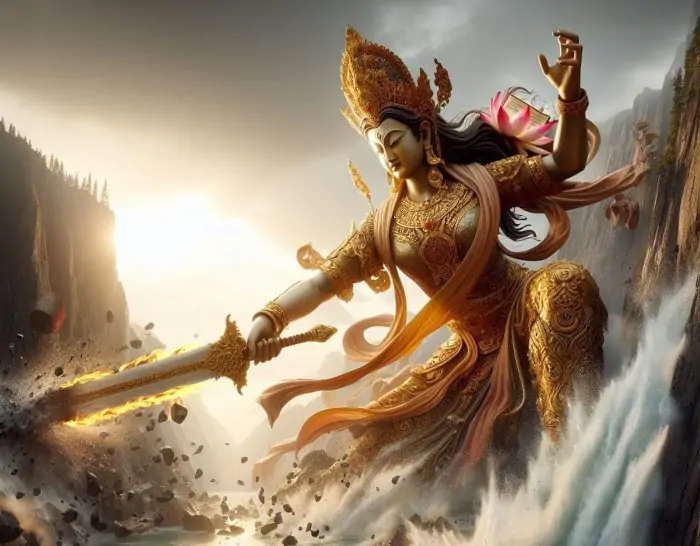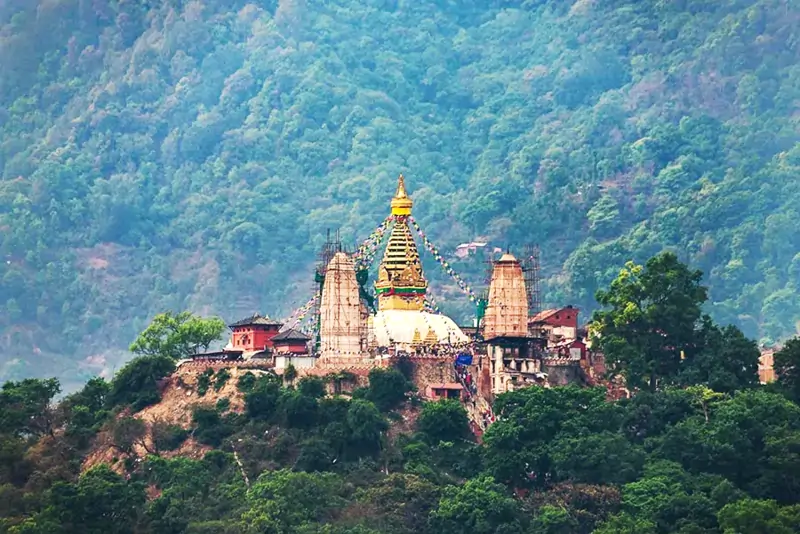Unveiling the Mystical Origins of Swayambhu
The enigmatic origins of Swayambhu, also spelled as Swoyambhu, a sacred site in the Kathmandu Valley of Nepal, are deeply intertwined with mythology and the divine book known as the Swayambhu Purana. This legacy book, dating back to the 14th century, is a treasure trove of Newari culture and the fascinating tale of Swayambhu’s inception.
Swayambhu: A Self-Born Marvel
The very name “Swayambhu” is derived from two Sanskrit words: “Swayam,” meaning self, and “Bhu,” meaning born, which means “self-born”. This term aptly encapsulates the essence of Swayambhu, a place with a mystical origin story.
The Golden Age and the Sacred Lake
In the distant past, during the Satya Yuga or the Golden Age, the Kathmandu Valley was an awe-inspiring expanse, measuring 14 miles by 14 miles, encompassed by imposing mountains and dense forests. This sacred land was crowned by a magnificent lake known as Taodhanahrada, also called Nagarasahrada or Nagabasdaha, symbolizing the kingdom of serpents, Nagas.

Vipaswi Buddha’s Divine Act
Legend has it that the first Buddha (1st of 7 Buddhas), named Vipaswi, resided in a place called Bandhumati Nagara, south of the present-day Kathmandu Valley. Upon hearing of the holy lake Taodhanahrada, he and his disciples embarked on a pilgrimage. After bathing ceremonially in the lake, Vipaswi Buddha noticed an absence of lotus flowers amidst the lush flora surrounding the lake. Determined to rectify this, he planted a lotus seed from the top of the nearby Nagarjun mountain, reciting a mantra as he did so.
The Emergence of Swayambhu Dharmadhatu
As the Golden Age came to an end, a second Buddha (2nd of 7 Buddhas), Sikhi Buddha, resided in the region known as Aruna, perhaps the current Arun Koshi area of Nepal. While delivering teachings to his disciples in his Vihara, an earthquake shook the land. Buddha Sikhi explained that the lotus seed planted by Buddha Vipaswi had blossomed into a thousand-petaled lotus on the Great Lake Nagavasahrada. Atop this lotus appeared Swayambhu Dharmadhatu, the Adi Buddha, radiating a dazzling flame of light. Sikhi Buddha decided to merge himself with this luminous presence, attaining immediate enlightenment.
The Arrival of Buddha Viswabhu
The third Buddha (3rd of 7 Buddhas), Viswabhu, made his way to the holy lake and the mesmerizing Swayambhu Dharmadhatu with his disciples. On a peak southeast of the lake, known as Phullochcha (today’s Pulchowk), he commenced meditation. His unwavering devotion caused another earthquake. Buddha Viswabhu prophesied the arrival of a Bodhisattva from MahaChin (Great China) who would drain the lake, creating the fertile Nepal Valley.
Manjushri’s Divine Intervention
In the midst of the Tetra Yuga (Second Era), during the time of Hindu god Rama, Bodhisattva Manjushri also known as Manju Devacharya or Manju Dev Acharya, resided atop the Panchasirva Parvata (five peaks) in MahaChin (Great China). While meditating, he sensed the presence of the holy Great Lake Nagabasdaha and the radiant Swayambhu Dharmadhatu. Driven by a profound purpose, he set forth to visit the lake. Realizing that draining the lake would make Swayambhu Dharmadhatu more accessible to pilgrims and allow for human settlement in the valley, Manjushri surveyed the area. He identified the lowest point, the Kachhapal Parvata (Chobar Gorge), and with his sword, he sliced through the hill, releasing the water.

Birth of Swayambhu Hill
As the waters receded, the Vajrakuta Parvata revealed itself, bearing the Swayambhu Dharmadhatu. This hill is known today as Swayambhu Hill. Manjushri, in his compassion, created a smaller lake named Taudaha for the serpents displaced from the original lake. He also invoked Goddess Guheswori at the site known today as Guheswari and established the country, naming it “Manjupattan.” Dharmakar, a prince from China, whom Manjushri had brought with him, became the first king of the Manjupattan valley. Today it’s known as Kathmandu Valley.
The Legacy of Manjushri and the Bajracharya Community
According to Pandit Badri Ratna Bajracharya, Manju Dev Acharya (Manjushri) was the first to establish Buddhism in Nepal during the middle of Tetra Yuga. Manju Dev is believed to be the author of the Hevajra tantra of Vajrayana Buddhism and is considered the first Bajracharya – Teacher of Vajrayana. Manjushri’s legacy was carried forward by his heir, Gunakar Acharya, who introduced the procedures for Abhishek, the ritual to become a Bajracharya in Nepal.
Shantikar Acharya: The Protector of Swayambhu
In the 5th century, Shantikar Acharya, formerly known as King Prachanda Dev from Gauda (now Bengal, India), played a crucial role in preserving Swayambhu Dharmadhatu. After visiting Swayambhu, he received Acharyabhishek from Gunakar Acharya and transformed into a Bajracharya. He covered the Swayambhu Dharmadhatu and erected the grand Swayambhu Maha Chaitya, a testament to his dedication to preserving this sacred site.
Conclusion
The enchanting tale of Swayambhu and the Bajracharya community is not just a story; it’s a timeless journey across eras, weaving through the mystical landscapes of the Kathmandu Valley. From the serene depths of the Great Lake Taodhanahrada to the transformative actions of the Bodhisattva Manjushri, each step in this saga reveals a rich tapestry of spiritual awakening and cultural evolution. The lotus seed, planted by the first Buddha Vipaswi and nurtured by successive enlightened beings, blossomed into the radiant Swayambhu Dharmadhatu, symbolizing enlightenment’s eternal flame.
As Manjushri reshaped the physical and spiritual contours of the valley, his vision gave birth to a new era, where the teachings of Buddhism flourished under the guardianship of the Bajracharya lineage. This lineage, rooted in deep wisdom and tradition, continues to uphold the principles of Buddhism, guiding the community toward enlightenment and inner peace. In the heart of Nepal, the Swayambhu Maha Chaitya stands as a monumental testament to this enduring legacy, a beacon of hope and spiritual guidance for generations to come.
In the Swayambhu saga, we find not just ancient myths but living truths, a reminder of our interconnectedness with the past and our collective journey towards a brighter, more enlightened future.
References
- Swayambhu Purana, 14th century
- Mythological History of the Nepal Valley from Svayambhu Purana, Mana Bajra Bajracharya
- Buddhism in Nepal, Badri Ratna Bajracharya

